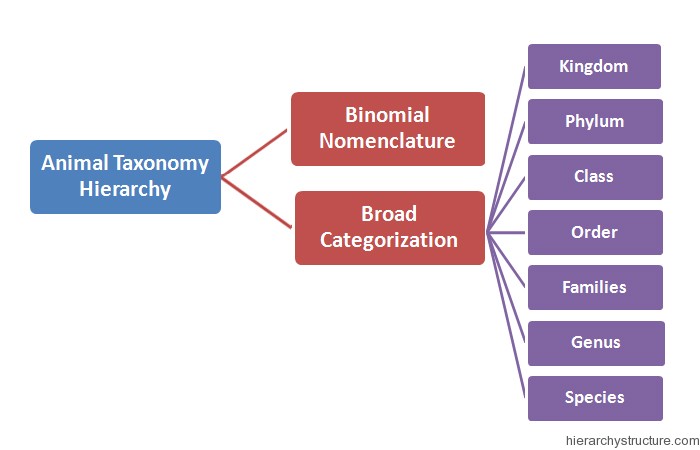Animal Taxonomy Hierarchy is a scientific procedure/ process used for the proper identification as well as for the classification of all animals on the earth. The famous Swedish scientist Carlous Linnaeus was the developer of this renowned system in the 18th century era.The group of the organisms which lie at the top of the Animal Taxonomy Hierarchy contains larger number of the organisms as compared to the organisms which lie at the lower levels.
The Animal Taxonomy Hierarchy by Linnaeus consists of two prime features that play a crucial reason behind the successful usage of Animal Taxonomy Hierarchy for the naming, classification and grouping of the animals.The first main feature being the BinomialNomenclature means the scientific name of an organism consists of a unique combination of just two terms, not more than that whereas the second feature corresponds to the ordering of all the animals in broad divisions.

- Binomial Nomenclature – This feature plays an important role in the unique classification and identification of all the organisms. Every organism’s name in according to Binomial Nomenclature in Animal Taxonomy Hierarchy consists of a unique combination of two different terms where the terms are the Genus name and the Epithet/ Species. Genus name is always capitalized. For example, we can demonstrate the scientific name for Humans in Taxonomy which will be Homo sapiens where Homo represents the Genus name whereas the sapiens refers to the Epithet/ Species.
- Broad Categorization – This formulates the second important feature of the Animal Taxonomy Hierarchy which provides a useful hand for the classification of organisms. This feature leads in the divisions of species in different broad categories. There are total seven different categories namely the Kingdom, the Phylum, the Class, the Order, the Family, the Genus and the last one being the Species and some of these categories further contain sub categories. The brief description for these categories is summarized as below:
- Kingdom: The largest as well as the first category is the Animal Kingdom. The five kingdoms are Plantae which consists of plants, Animalia which comprises of animals, Protista which comprises protisits, Fungi which consists of mold, mushrooms, yeast etc and last Monera which consists of three types of bacteria.
- Phylum: There can be many different Phyla within the Kingdom. The Phyla is responsible for the recognition of animals into further more small recognizable groups. Different Phyla are Artropoda, Chordata, Annelida and Mollusca etc.
- Class: Phyla further can be divided into more small groups referred as the Class namely Reptile, Aves, Mammalia, Amphibia and many more.
- Order: After Class, the next category is the Order. Each Class comprises of one or more Orders namely Primates, Chiropetra, Rodentia, Artiodactyla, Proboscidea etc. and many more.
- Families: The next category is Families. Orders can be further categorized as the Families like Felidae, Ursidae, Hyaenidae, Mustelidate, Canidae etc.
- Genus: After Families comes the next category the Genus namely Panthera, Neofelis, Felis and Acinonyx etc.
- Species: The lowest and the last category of Animal Taxonomy Hierarchy in Species which is result of further breaking down of the Genus. Genus name is always placed in front of the Species name.
